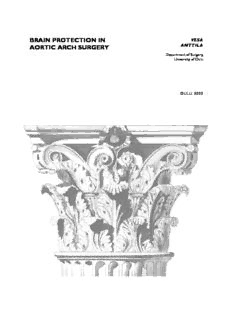
Brain protection in aortic arch surgery PDF
Preview Brain protection in aortic arch surgery
BRAIN PROTECTION IN VESA ANTTILA AORTIC ARCH SURGERY Department of Surgery, University of Oulu OULU 2000 VESA ANTTILA BRAIN PROTECTION IN AORTIC ARCH SURGERY Academic Dissertation to be presented with the assent of the Faculty of Medicine, University of Oulu, for public discussion in Auditorium 1 of the University Hospital of Oulu, on May 12th, 2000, at 12 noon. OULUN YLIOPISTO, OULU 2000 Copyright © 2000 University of Oulu, 2000 Manuscript received: 10 April 2000 Manuscript accepted: 12 April 2000 Communicated by Docent Matti Tarkka Docent Tero Sisto ISBN 951-42-5617-4 (URL: http://herkules.oulu.fi/isbn9514256174/) ALSO AVAILABLE IN PRINTED FORMAT ISBN 951-42-5616-6 ISSN 0355-3221 (URL: http://herkules.oulu.fi/issn03553221/) OULU UNIVERSITY PRESS OULU 2000 Anttila,Vesa,Brainprotectioninaorticarchsurgery DepartmentofSurgery,UniversityofOulu,P.O.Box5000,FIN-90014UniversityofOulu,Finland 2000 Oulu,Finland (Manuscriptreceived:10April2000) Abstract Retrogradecerebralperfusion(RCP)techniqueshavebeenadoptedinaorticarch surgeryforclinical use.TheclearbenefitsofRCParethatitreducesembolic injuryandprolongsthepermissibleperiod ofhypothermiccirculatoryarrest (HCA).Atthesametime,however,thereisagreatdealofevidence accordingto whichRCPmaybeassociatedwithanincreasedriskoffluidsequestrationand cerebral edema.InthecurrentstudyintermittentRCPwascomparedwith continuousRCPandHCAaloneto clarifyifperiodicalRCPdecreasesfluid sequestration(I). HCAisaneffectivemethodofcerebralprotection,butisassociatedwithlong cardiopulmonary bypasstimes,andcoagulationdisturbances.Wetestedthe hypothesisthatdeephypothermicRCP couldimprovecerebraloutcomeduring moderateHCA(IIandIII). Glutamateexcitotoxicityplaysanimportantroleinthedevelopmentofischemic braininjury. Thepurposeofthepresentstudywastodeterminetheefficacyof lamotrigine,aNa+channelblocker, tomitigate cerebralinjuryafterHCA(IV). Achronicporcinemodelwasusedinthepresentseries ofstudies.Hemodynamic, electrophysiologic,andmetabolicmonitoringwereperformeduntilfour hours aftertheinstigationofrewarming.S-100(cid:1)wasmeasuredupto20hours. Daily behavioral assessmentperformeduntildeathorelectivesacrificeontheseventh postoperativeday. AftercontinuousRCPthemedianfluidsequestrationvolumewas145(0-250)ml comparedwith -50(-100-0)mlafterintermittentRCP(p=0.04).Incomparisonof15(cid:2)CRCPtoHCAaloneduring moderate25(cid:2)Chypothermia,5/6 animalsintheRCPgroupsurvivedsevendayscomparedwith2/6 intheHCAgroup (p=0.04). The total histopathologic scores in the RCP(15(cid:2)C) group were lower than those for the RCP(25(cid:2)C)groupduringmoderate25(cid:2)Chypothermia(p=0.04).EEGbursts wererecoveredbetter intheRCP(15(cid:2)C)groupat3hoursafterthestartof rewarmingcomparedtoHCAgroup(p=0.05). TherateofEEGburstrecoverywashigherinlamotriginetreatedanimals comparedtoplacebo treatedanimalsafter4hoursduringtherewarming(p= 0.02).Amongtheanimalsthatsurvivedfor 7days,themedianbehavioralscore washigherinthelamotriginegroup(8)comparedwithcontrols (7)(p=0.02).TheresultsindicatethatintermittentRCPdecreasestherateoffluid sequestrationafter continuousRCP.ThecoldRCPatmoderatesystemic hypothermiaseemstoprovideabetterneuro- logicaloutcomethanthatwith moderatetemperatureRCP,afindingsuggestingthatenhancedcranial hypothermia isthemajorbeneficialfactorofRCP.TheNa+ channelblockerlamotrigine improves neurologicaloutcomeafteraprolongedperiodofHCA.Inconclusion, tworefinementsintheRCP conceptaretoadministeritatlowtemperaturesand iflongerperiodsofperfusionarenecessary,RCP shouldbeapplied intermittently. Keywords:retrogradeperfusion,hypothermiccirculatoryarrest,lamotrigine.
Description: